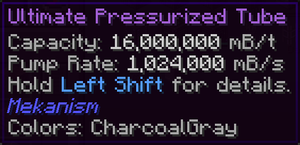Throughput: Difference between revisions
mNo edit summary |
|||
| Line 43: | Line 43: | ||
* Capacity: the capacity that individual pipe block contributes to the network | * Capacity: the capacity that individual pipe block contributes to the network | ||
* Pump rate: how fast the pipe can accept/pull when set on "pull" with a [[Configurator]] | * Pump rate: how fast the pipe can accept/pull when set on "pull" with a [[Configurator]] | ||
The power/fluids/gases transfer mechanics through a pipe network work as follows: | The power/fluids/gases transfer mechanics through a pipe network work as follows: | ||
Revision as of 12:58, 23 July 2020
Universal Cable, Pressurized Tube, Mechanical Pipe have in their tooltip both a capacity and pump rate. This page tries to clarify how this comes together.
In Mekanism v10, Universal Cables have no Pump Rate indicated. Their actual pump rate is equal to the capacity of a single cable block.
Definitions
For convenience, we will use the following terms for the remainder of this page:
- Pipe: applies to any cable, pipe or tube
- Network: is a series of pipes of the same type connected together
- Acceptor: container or power consumer receiving power, fluids or gases from the network (energy cubes, machines drawing power/fluids/gases, tank valves, etc.)
- Emitter: any source of power, fluids or gases connected to and sending its contents to the network
Pipe networks
When right clicking a pipe network with the Network Reader, we get this kind of output:
This is for an empty Pressurized Tube network.
- Transmitters: number of individual pipe blocks forming the network (this does not count any machine ejecting fluids/gases/power to the network)
- Acceptors: number of acceptors connected to the network
- Needed: this is just Capacity - Buffer (see below)
- Buffer: the contents of the pipe. The value can range from 0 (indicated as "none") up to Capacity.
- Throughput: the amount of power/fluids/gases that transit through the network per tick.
- Capacity: The total power/fluid/gases capacity of the network. This is equal to the number of transmitters multiplied by the capacity of an individual pipe block
Another example with a Mechanical Pipe network that shows a non-empty buffer and actual throughput:
Note that a 0 value for the buffer means that the acceptors on the network drain it faster than the emitters send.
Throughput

The tooltip of a pipe shows:
- Capacity: the capacity that individual pipe block contributes to the network
- Pump rate: how fast the pipe can accept/pull when set on "pull" with a Configurator
The power/fluids/gases transfer mechanics through a pipe network work as follows:
- A pipe network can accept up to its max capacity from emitters as fast as they try to send it if they are auto ejecting via pipes set on normal (not pull)
- A pipe network tries to eject its entire buffer evenly among all acceptors each tick




